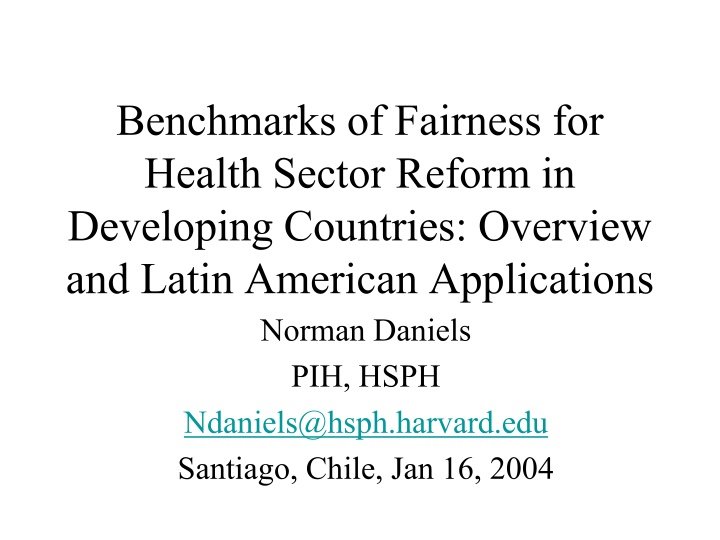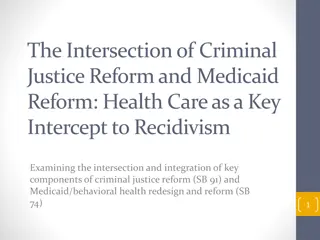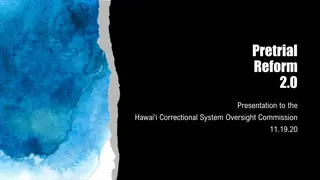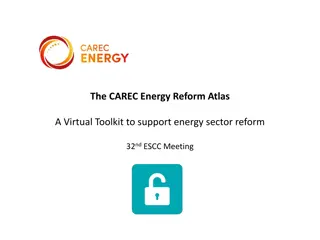Benchmarks of Fairness in Health Sector Reform: Overview and Applications
Overview of benchmarks for fairness in health sector reform, tracing historical development, adapted benchmarks, connections to social justice, structure of benchmarks, and comparison with the WHO framework. Covers key aspects such as intersectoral public health, financial barriers, equity in access, comprehensive benefits, equitable financing, and democratic accountability.
Download Presentation

Please find below an Image/Link to download the presentation.
The content on the website is provided AS IS for your information and personal use only. It may not be sold, licensed, or shared on other websites without obtaining consent from the author.If you encounter any issues during the download, it is possible that the publisher has removed the file from their server.
You are allowed to download the files provided on this website for personal or commercial use, subject to the condition that they are used lawfully. All files are the property of their respective owners.
The content on the website is provided AS IS for your information and personal use only. It may not be sold, licensed, or shared on other websites without obtaining consent from the author.
E N D
Presentation Transcript
Benchmarks of Fairness for Health Sector Reform in Developing Countries: Overview and Latin American Applications Norman Daniels PIH, HSPH Ndaniels@hsph.harvard.edu Santiago, Chile, Jan 16, 2004
Historical Development of the Benchmarks 1993 Clinton Task Force 1996 Benchmarks of Fairness for Health Care Reform Oxford University Press. Pilot work in Pakistan, 1997 1999-2000 Adaptation: Pakistan, Thailand, Colombia, Mexico: Daniels, Bryant et al Bulletin of WHO, June 2000 2001-3 Demonstration Phase: Mexico, Portugal, Pakistan, Thailand; Vietnam Cameroon, Ecuador, Nicaragua, Guatemala, Chile, Yunnan (China), Sri Lanka, Bangladesh, Zambia
The Adapted Benchmarks 1. Intersectoral public health 2. Financial barriers to equitable access 3. Nonfinancial barriers to access 4. Comprehensiveness of benefits, tiering 5. Equitable financing 6.Efficacy,efficiency,quality of health care 7. Administrative efficiency 8. Democratic accountability, empowerment 9. Patient and provider autonomy
Connections to social justice Equity B1Intersectoral public health, B2-3 Access, B4Tiering, B5 Financing Democratic Accountability B8, B9Choice Efficiency B6 Clinical Efficacy and quality B7 Administrative efficiency
Structure of BMs B1-9 Main Goals Criteria -- Key aspects Sub criteria-- main means or elements Evidence Base + Evaluation Indicators Scoring Rules
WHO Framework vs BM WHO BM Scope Cross national Nat, subnat Objective Current perform Reform eval Purpose Motivate Deliberate Product Index, ranks Scores Who uses National pol mk Various Requires Good info Info, tr. people Problems Inform change? Subjectivity? Overlap Move to reforms complementary
B1: Intersectoral Public Health Degree to which reform increases per cent of population (differentiated) with: basic nutrition, adequate housing, clean water, air, worplace protection, education and health education (various types), public safety and violence reduction Info infrastructure for monitoring health status inequities Degree reform engages in active intersectoral effort
B2: financial barriers to access Nonformal sector Universal access to appropriate basic package Drugs Medical transport Formal Sector Social/Private Insurance Encourages expansion of prepayment Family coverage Drug, med transport Integrate various groups, uniform benefits
B3: Nonfinancial barriers to access Reduction of geographical maldistribution of facilities, services, personnel, other Gender Cultural -- language, attitude to disease, uninformed reliance on traditional practitioners Discrimination -- race, religion, class, sexual orientation, disease
B6: Efficacy, efficiency and quality of health care Primary health care focus Population based, outreach, community participation, integration with system, incentives, appropriate resource allocation Implementation of evidence based practice Health policies, public health, therapeutic interventions Measures to improve quality Regular assessment, accreditation, training
B8: Democratic accountability and empowerment Explicit public detailed procedures for evaluating services, full public reports Explicit deliberative procedures for resource allocation (accountability for reasonableness) Fair grievance procedures, legal, non-legal Global budgeting Privacy protection Enforcement of compliance with rules, laws Strengthening civil society (advocacy, debate)
Why is evidence base important? Evidence base makes evaluation objective Making evaluation objective means: Explicit interpretation of criteria Explicit rules for assessing whether criteria met and the degree to which alternatives meet them Objectivity provides basis for policy deliberation Gives points of disagreement a focus that requires reasons and evidence
Evidence Base: Components Adapted Criteria--convert generic benchmarks into country-specific tool Reflect purpose of application Reflect local conditions Indicators Outcomes Process revisability Scoring rules Connect indicators to scale of evaluation Specify in advance
Process of selecting indicators Clarity about purpose Type of criterion determines type of indicator Outcomes vs process indicator appropriate Standard vs invented for purpose Requires clarity about mechanisms of reform Availability of information Consultation with experts Final selection in light of tentative scoring rules Further revision in light of field testing
Scoring Benchmarks Reform relative to status quo -5 0 +5 Or use qualitative symbols, --- or +++
Scoring Rules: General Points Map indicator results onto ordinal scale of reform outcomes Final selection of indicators should be done as scoring rules are developed, so refinements can be made Scoring rules should be adopted prior to data collection to increase objectivity, but may have to be revised in light of problems
Two approaches to evidence Thailand: survey of various groups judging based on discussion of evidence Strengths: range of views, involvement of larger groups Weakness: vaguer basis for judgment? Guatemala, Cameroon: team evaluation based on indicators, scoring rules Strengths: clarity about evidence base for evaluation Weakness: trained team, narrow input
Guatemala, Ecuador: Stage 1: Theoretical adaptation Conceptualizing public health The set of actions implemented through a health care system which includes personal, collective, environmental and health promotion interventions. The delivery of services can be through public or private providers (with public funding) and its design and evaluation concerns providers, financers (public and private) and regulators. Output: Working document with specific version adapted to the context of Guatemala and Ecuador
Adapted benchmarks Adaptation to Public Health Benchmark I: Intersectorial public health Benchmark II: Universal access to public health interventions Preventive services, Curative services Social protection against catastrophic illness Reduction of financial barriers Reduction non-financial barriers. Benchmark III: Equitable and sustainable financing Equity in health financing Sustainability in public financing Benchmark IV: Ensuring the delivery of effective public health services Technical quality (standard treatment guidelines) Efficiency (relation between inputs and outputs) User satisfaction Benchmark V: Accountability Social participation, community involvement in the evaluation and monitoring of inequities in health care delivery and resource allocation Defined by Daniels et al (2000) Benchmark I: Intersectorial Public Health Benchmark II: Financial equitable access Benchmark III: Non financial barriers to access Benchmark IV: Comprehensiveness benefits and tiering Benchmark V: Equitable financing Benchmark VI: Efficacy, efficiency and quality of care Benchmark VII: Administrative efficiency Benchmark VIII: Democratic accountability and empowerment Benchmark IX: Patient and provider autonomy barriers to of
Stage 2: Data collection and data analysis tools Intervention level: Province/Department Decentralization transferred policy-implementing responsibilities and resources to the sub-national level. Development of tools and field testing follows from the provincial to the municipal level. Outputs: Data collection: questionnaires (quantitative & qualitative) to assess criteria and indicators for each benchmark Data analysis: index to assess inequities, health expenditures analysis through proxies (drug consumption), excel database.
Stage 3: Field testing Outputs: Data collection tools for benchmarks I to V.
Examples of application Starting with an analysis of inequities in the delivery of basic health care services and inequities in the distribution of basic resources.
INDEX OF PRIORITY FOR HEALTH SERVICE (IPSS) IPSS= (Ciin-CDxin ) + (Ciap-CDxap )+ (Cips-CDxps ) Va Ciin Ciap Cips 3 IPSS= Index of priority for health services Ciin= Ideal coverage for immunization (100%) CDxin= Immunization coverage for district X Ciap= Ideal coverage for antenatal care (100%) CDxap= Antenatal coverage for district X Cipss=Ideal coverage for supervised deliveries (100%) CDxps=Coverage of supervised deliveries for district X Va= Sum of three values NOTES: The coefficient will go from 0.01 up to 0.99 The higher the value, the higher the priority for the delivery of basic services to the population
INDEX OF RESOURCES IR = (GPDx X 0.4 ) + (MDx X 0.3)+ (FDa X 0.3) GPDa MDa FDx IR= Index of resources GPDx= per capita expenditure district x GPDa= District with the highest per capita expenditure MDx= Medical staff per population for district x MDa= District with the highest number of medical staff/pop FDa= District with the highest number of health facilities per population (district with the lowest number of inhabitants per health facility) FDx= health facility per population in district x
Indexes DISTRICTS SAN MIGUEL IPSS 0.51 0.47 0.38 0.36 0.33 0.33 0.28 0.15 IR 0.29 0.34 0.81 0.38 0.59 0.55 0.47 0.34 CUBULCO GRANADOS SAN JERONIMO PURULHA EL CHOL RABINAL SALAMA
IPSS VERSUS IR 0.90 0.80 0.70 0.60 0.50 IPSS IR 0.40 0.30 0.20 0.10 0.00 SAN MIGUEL CHICAJ CUBULCO GRANADOS SAN JERONIMO PURULHA EL CHOL RABINAL SALAMA
Examples of application Benchmark II: Universal access to integrated public health services Definition of integrated public health: the delivery of services related to curative, preventive and health promotion, as well as services for both, transmittable and non-transmittable diseases and chronic diseases. An integrated effort should include some forms of protection against catastrophic diseases.
CRITERIA INDICATORS RESULTS Access to the curative services included in the basic package of services % of population receiving the services at any of the three subsystems (public, social security and private) with public funding N/A Access to preventive services included in the basic package of services % of population receiving the services at any of the three subsystems (public, social security and private) with public funding N/A The provision of services aimed at non-transmittable, chronic and degenerative diseases % health facilities at the district level offering services for the following problems: diabetes, hypertension, cardiovascular diseases, screening cervical cancer 42% (5 facilities from a total of 12) Actions implemented aimed to protect the individuals against the socio-economic consequences of catastrophic illnesses % of health districts or municipalities that have a catastrophic disease fund for their population 0%. This type of benefit does not exist in the area
CRITERIA INDICATORS RESULTS Reduction financial barriers of % health facilities in a given district in which the population contributes with cash or in kind resources to the delivery of basic health care services (both curative and preventive) 0% (interviews to health authorities 100% (focus groups with community members) 30% (see table & graph for distribution) 59% (see table &graph for distribution) Reduction of non- financial barriers % of health personnel (by category) that speak the local indigenous language % of health staff (by category) who are women % of health facilities offering services in a schedule that is appropriate to the occupation and schedules of the local population (24 hours emergency; OPD services offered until late evening) % of first level health facilities that experienced shortage of basic resources during last year (equipment, drugs, medical staff) 25% (3 out of 12 facilities) (pending tabulation)
Instrument #1b: Human Resources (feed analysis of non- financial barriers and inequities in the distribution of health personnel) PERSONNEL Doctors Nurses Auxiliary Nurses Rural health technicians Institutional facilitators Community facilitators TOTAL WOMEN SPEAK LANGUAGE 12 2 16 16 17 17 9 0 4 1 12 4 0 2 2 3 2 12
PERSONNEL Community facilitators Instiutional facilitators CATEGORY Rural health technicians SPEAK LANGUAGE WOMEN TOTAL Auxiliary Nurses Nurses Doctors 0 2 4 6 8 10 12 14 16 18 NUMBER
Lessons learned Benchmarks and their potential contribution to the analysis of inequities Start by analyzing inequities in the delivery of basic health services and inequities in the distribution of basic resources From here the benchmarks can help to explain the factors that may be related to the observed inequities
Lessons learned Difficulties of transferring concepts into practice Identifying and assessing indicators for accountability, social participation, intersectorial work, etc. Limitations related to health information systems Existing system collects mainly traditional information (health service production) and has little flexibility to introduce new indicators (intersectorial work and others)
Lessons learned Skills in research team Actors at sub-national levels require skills development Qualitative research Potential users and data collectors have little experience & skills for qualitative research Planning cycle The benchmarks approach seems more useful as an approach that helps the planning cycle: evaluate existing situation-design interventions-implement-evaluate. Issues related to equity and social justice within the health system can be addressed in each of the stages of the planning cycle.
Ecuador Team members: 12 people representing the following institutions: Universidad Nacional de Loja, PAHO-Ecuador, ALDES, Universidad de Cuenca, Fundaci n Eugenio Espejo, Harvard School of Public Health (USA) Liverpool School of Tropical Medicine (UK)
Work carried out during the year 2003 5 workshops (two days per workshop) 9 work-meetings (one day or less) Outputs: Adapted version to Ecuador of the generic matrix (Daniels et al 2000) with specific indicators for each benchmarks criteria Development of data collection instruments to assess indicators
Adaptation of generic matrix Followed simmilar process to Guatemala Exchange of ideas and indicators between the Guatemalan team and the Ecuadorian team. Adaptation in Ecuador emphasize the assessment of recent health policies: national health system law, free MCH services law
Field application (Jan-April 2004) Two provinces: Azuay y Canar 25 health facilities (11 MoH 7 social security; 7 NGO s; 1 local government. In addition, a household survey that will allow to investigate socio-economic inequalities and its relation with access to reproductive health and MCH services.
Expected use of findings (field application) Inform local government health plans Inform advocacy groups in Azuay and Canar Field testing of the benchmarks approach as a tool that can aid the monitoring and evaluation of health policy implementation
APHA Later Zambia--HIV/AIDS Yunnan, China-rural reform Ecuador, public health, comprehensive Vietnam-comprehensive reform Pakistan- community use Chile, Nicaragua, Sri Lanka, Nigeria (ACOSHED), Bangladesh Thailand Guatemala Cameroon
Plans for Benchmarks Research Network for all sites, other efforts at monitoring reform Funding for country level projects using adapted benchmarks Coordination with WHO, regional organizations of WHO, World Bank, USAID























